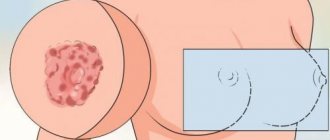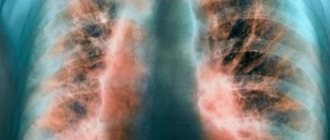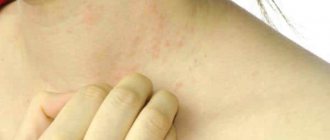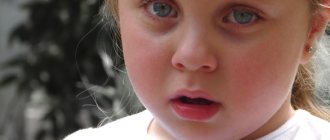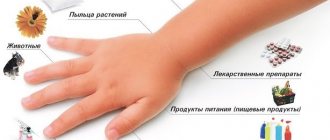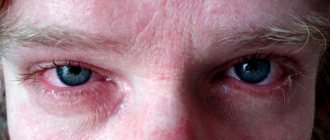Allergic dermatitis is the most common skin disease in children, occurring already in the first year of a baby’s life. The pathology develops against the background of an allergic reaction to any irritant and is manifested by inflammation of the skin. To prevent allergic dermatitis in children from becoming chronic, parents should promptly diagnose the disease and begin treatment as quickly as possible.
What is atopic dermatitis?
Atopic dermatitis (infantile eczema) is a non-infectious chronic inflammatory skin disease that is immunoallergic in nature. Both boys and girls get sick with the same frequency.
The most common “folk” synonym for this disease is the word “diathesis”. However, these concepts should not be confused, because diathesis is not a disease at all, but only a predisposition to certain allergic diseases. From this we can conclude that not all children suffering from diathesis will eventually develop atopic dermatitis. You can learn about the differences between allergies and atopic dermatitis in this article.
It should also be noted that it is incorrect to call atopic dermatitis a purely skin disease. Only manifestations of the disorders that exist inside the body are visible on the skin. First of all, it is an imbalance in the immune, digestive, nervous and endocrine systems. For example, the body cannot neutralize a substance in the liver or remove it through the kidneys or lungs. Then this substance begins to be perceived by the body as foreign (antigenic) and the immune system begins to produce antibodies against it (immunoglobulins). In the process of this, inflammatory mediators are released, which, in fact, cause the occurrence of manifestations on the skin (the appearance of redness, swelling, itching, pain).
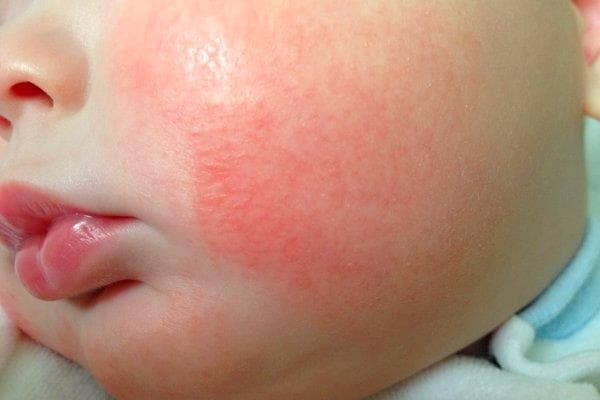
Why does a child develop allergic dermatitis?
It is necessary to clearly understand that the rash in this disease is not the most important pathological symptom, but only an external manifestation. In fact, much more serious pathological reactions occur in the baby’s body. Due to the immaturity of the digestive system, some foreign agents cannot be digested and are absorbed into the blood. The liver is also not yet ready to completely neutralize these substances. As a result, they are perceived by the immature hyperreactive immune system as foreign antigens and an allergic reaction is formed, one of the manifestations of which is a rash on the skin.
Foreign antigens can enter the general bloodstream, triggering a cascade of pathological reactions, in the following ways:
- Through the digestive tract
- Through the bronchial tree during breathing
- Directly through the skin
The main causes and factors contributing to the occurrence of the disease
The difficulty in treating atopic dermatitis is due precisely to the fact that there is no main cause that can be influenced and cured (there is no specific etiotropic therapy that is aimed at eliminating the cause of the disease). Atopic dermatitis is a multifactorial disease, i.e. having many causes and prerequisites for its occurrence, therefore it is not always possible to understand from what moment it begins to progress.
The main factor is a family history of allergies. Like any allergic disease, heredity plays a huge role in the occurrence of atopic dermatitis. If there have been cases of hypersensitivity of any type in the family (i.e., any type of allergy: bronchial asthma, hay fever), then the likelihood of the disease in the child increases by approximately 1.5-2.5 times.
Separately, factors contributing to the appearance of atopic dermatitis should be considered, depending on age.
Why does atopic dermatitis often occur in infancy?
Often (more precisely, in about 70% of cases) this diagnosis is made to children in infancy. Why is this so? As mentioned above, when protein comes from food and the body cannot process it, an allergic reaction begins. The fact is that in infancy, enzymatic systems are very poorly developed, so their strength is not always enough to process (hydrolyze) a particular protein. That is why, in 80% of cases, children “outgrow” atopic dermatitis without any consequences for the body - enzymatic systems become more mature and can hydrolyze complex proteins.
In infants, dermatitis occurs, most often as a result of exposure to the following factors:
- When introducing mixtures or complementary foods. Atopic dermatitis occurs extremely rarely in breastfed newborns, because, as you know, mother's milk is ideal for her baby. Usually problems begin when the amount of breast milk decreases and the need to introduce formula arises. Cases of the disease occur even more often with the introduction of complementary foods (after 4-5 months). The situation is aggravated by the fact that it is at this age that the DPT vaccine is given, so the mother may think that this is a reaction to vaccination.
- When animal protein enters the body (for example, when feeding a child cow's milk up to 8-9 months). Therefore, it must be taken into account that even if breastfeeding is impossible for some reason, you need to feed the baby only with highly adapted formulas.
- When exposed to an allergen on the skin of a newborn. A baby's skin is very thin, sensitive and prone to irritation. For example, if parents used a new washing powder or applied cream to the skin, allergic dermatosis may appear.
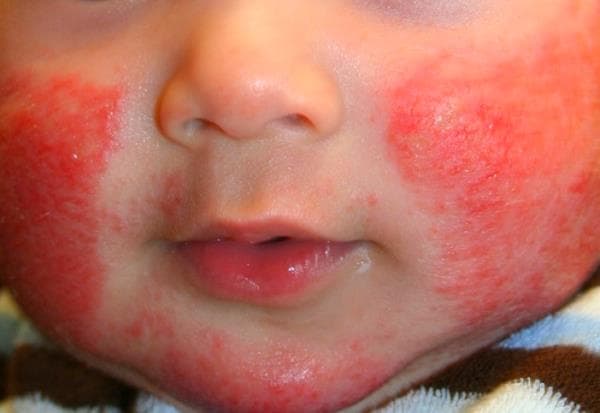
How does inflammation occur?
Rashes are a response of the human immune system to an allergen coming from outside. When the allergen first enters the child’s body, its size is insignificant and is not able to be recognized by the immune cells of the child’s body. It forms a bond with certain proteins, and also with bacteria and viruses. Such compounds are irritants, and the main guardians of the immune system, lymphocytes, “attack” this ligament and destroy it. Subsequently, the “cellular memory” of lymphocytes is triggered and the next time an allergen enters the body, the protective function of lymphocytes is triggered again and, consequently, allergic dermatitis occurs.
The problem of the disease is not only in the skin, it is located much deeper - inside the body. The irritant or allergen that provokes allergic dermatitis in a child enters the body during food intake, when the allergen gets on the skin during the inhalation of pollen, dust, aerosols and other things.
Why can atopic dermatitis appear after a year?
In early preschool age (up to 4 years), another 20% of cases of atopic dermatitis are detected. The development mechanisms are the same, but at this age other factors that provoke the disease may also become involved. The main ones:
- Food allergens. In the second year of life, the child is either no longer breastfed, or the number of breastfeedings is reduced to 1-2 times a day. In this regard, the diet is expanding and it is not always possible to control which product the allergy has occurred to. That is why you need to introduce new foods (especially sweets) with caution if you are prone to allergies. Under no circumstances should 2 or more food products be introduced at the same time. For example, if you want to feed your child fruit puree from a banana and an apple, then you need to first give only an apple for 5-7 days, gradually increasing the amount. And then give banana for another 5-7 days according to the same principle. And only after this, if an allergy has not occurred, can you give 2 products at once.
- Household allergens. This group includes everything that a child encounters in everyday life: plant pollen, dust, pet hair and much more. All this can affect both the skin and if it enters the respiratory tract.
- Stress. Usually, at the age of 2-3 years, a child begins to attend kindergarten, and almost always for him this is a stressful situation, which can serve as a trigger for the development of an allergic disease.
- Immunodeficiency conditions, as well as hypovitaminosis.
Cases of atopic dermatitis in children can occur after 4 years of age. And, as practice shows, the later the disease occurs, the more severe its course.
Will the symptoms of dermatitis go away with age?
Infantile dermatitis is an inflammatory skin reaction resulting from high sensitivity to external irritants.
The occurrence of the disease in children is associated with a genetic predisposition to allergies. Sometimes this is an acquired feature of the body. Most often, these childhood dermatitis appear in the first months of life (diathesis, seborrheic crusts, diaper dermatitis on the butt, etc.), and after 4 years they are quite rare. The following categories of children are at high risk of developing dermatitis:
- babies whose mothers suffered infectious diseases during pregnancy;
- parents suffering from food or other allergies;
- born to women who have suffered complications during childbirth or pregnancy;
- children who suffered viral diseases in infancy;
- children who were fed with unadapted formulas, highly allergenic foods, and also prematurely;
- children whose mothers used medications during pregnancy;
- children who are brought up in an environment where hygiene rules are not followed;
- children who are constantly in an environment that is contaminated with harmful substances.
These are generalized reasons for the appearance of this disease. Each type has its own symptoms and causes, which significantly affects the method of treatment.
Seborrheic dermatitis. This type of disease appears mainly on the baby’s head and quite rarely occurs on the main parts of the body. The main symptom is the appearance of fatty yellow crusts on the head. Sometimes the disease manifests itself on the neck, ears, groin, chest. The peculiarity is that the itching is mild or absent altogether.
The cause of the disease is the fungus Malassezia furfur. It is this fungus that is “responsible” for the causes of seborrheic dermatitis and in its treatment, if required, means are used to combat this type of fungus.

This type of skin disease appears on the head in children 2-3 weeks of age. If the necessary treatment does not occur, an additional bacterial infection is likely to form. This further significantly complicates the course and diagnosis of the disease.
Atopic dermatitis. This type of dermatitis is characterized by skin inflammation. Symptoms that distinguish it from similar types of dermatitis are dry skin, redness, the formation of water bubbles, and peeling. The rash is extremely itchy. Most often it appears on the hands and face, sometimes on other parts of the body.
The main reason why dermatitis appears: the genetic predisposition of the child. Upon closer examination, a blood test reveals a high level of antibodies responsible for allergic reactions. These indicators indicate that even a small pathogen can cause an allergy. Allergens enter the body in three ways: through food and liquid intake, through contact with skin, and through the respiratory system.
Often in children who are prone to atopic dermatitis, dysbiosis appears along with other symptoms. It appears in children under six months of age. But there may be cases when the disease is observed in adolescents and preschoolers. Moreover, the symptoms of the disease are different in children of different ages.
Symptoms in children under 2 years of age:
- presence of small water bubbles;
- red rashes in the groin, on the arms near the elbow joints, on the neck and face;
- the presence of small crusts that have a yellowish tint;
- the appearance of small cracks in the skin;
- significantly pronounced itching of areas infected with dermatitis;
- dry skin accompanied by peeling.
Manifestations of atopic dermatitis in preschool children:
- the origin of the disease takes on a chronic form, which is characterized by acute remissions and periods;
- inflammations usually form in skin folds; cases of formation on the legs and arms are common;
- sleep disorder due to constant itching;
- dryness and thickening of inflamed skin areas or the presence of rashes in the form of water blisters.
Diaper dermatitis. Many parents know this skin disease. This is an inflammatory skin disease of the genitals, thighs and buttocks, which is caused by prolonged contact with baby feces.
The reasons for the development of dermatitis in children are explained by the following factors:
- failure to comply with hygiene procedures (changing diapers with dirty hands);
- failure to comply with child hygiene rules (rare bathing and washing);
- allergic reaction to washing powder and products used in caring for the child’s body, incorrectly chosen soap;
- diapers chosen incorrectly in size (wearing diapers of the wrong size rubs the baby’s skin, which leads to dermatitis);
- food allergies;
- intestinal dysbiosis.
The main manifestations of diaper dermatitis:
- the formation of an unpleasant odor and pustules (a sign of additional infection);
- high sensitivity of damaged skin areas during touch;
- small rashes in the perineal area and redness of these skin areas;
- irritability and restlessness of the baby;
- severe itching;
- poor sleep;
- causeless crying.
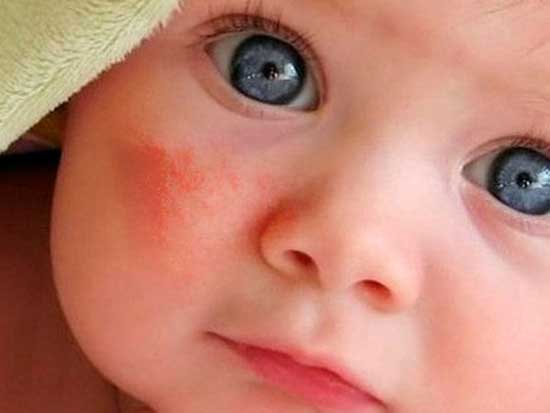
Diaper dermatitis appears only in the area of contact with the diaper: on the butt, groin, legs. If this kind of rash appears behind the ears, on the head, on the legs, arms and other parts of the body, then this is a completely different type of skin disease, which can be determined even by a photo by an allergist, dermatologist or pediatrician.
Candidal dermatitis. This type of disease is a type of diaper dermatitis, and its name is explained by the fungus Candida albicans, which causes the appearance of dermatitis. It should be noted that inflammatory skin diseases can appear even with careful adherence to the baby’s personal hygiene rules.
Diaper candidiasis is characterized by patchy and red edges of a painful rash. Foci of infection are located in the groin and can be wet or dry.
The disease is a type of allergic dermatitis and manifests itself when an irritant comes into constant contact with the baby’s skin. As a rule, it appears in areas of constant friction of clothing (on the legs and arms), the use of cream, rough seams that irritate the child’s body.
The main symptoms of the disease are symmetrical formations of red rashes, which are accompanied by itching. Often the findings appear in the form of fluid blisters that open, leaving moist sores. Infected areas are characterized by swelling of the skin.
If the cause is not eliminated and treated in a timely manner, the disease begins to take on a chronic form. Therefore, it is important to consult a doctor in a timely manner to determine the irritant and avoid relapse.
Viral dermatitis. This type of disease is considered one of the symptoms of an infectious disease or its consequence. Infectious dermatitis is most pronounced during chickenpox, scarlet fever, measles and typhoid fever. It can appear anywhere on the body, including on the legs and arms and even on the buttocks.
- skin irritation;
- swelling;
- itching;
- burning;
- in places where the skin is red, the temperature rises;
- the appearance of a rash or scales;
- the appearance of blisters;
- deterioration of general condition.
Most often they occur in the first year of a child's life. Sometimes children get sick for the first time even at an older age. If a child had manifestations at an early age, then relapses are quite possible.
In most cases, approximately 60-70%, the signs of atopic dermatitis in children disappear over time, but in the rest, the disease persists in the child and accompanies him throughout his life, periodically renewing. The severity of the pathology directly depends on the period of its occurrence, therefore, with early onset, dermatitis is especially severe.

Does atopic dermatitis in children go away with age?
Doctors say that if, in parallel with atopic dermatitis, children develop another allergic disease, for example, bronchial asthma or hay fever, then the symptoms will appear almost constantly, which will significantly worsen the patient’s quality of life.
The first manifestations of the disease begin at an early age. There have also been cases where the first reaction occurred in adolescence or in adults.
Interesting statistics: the stronger sex is more susceptible to the disease.
When atopic dermatitis develops, the symptoms are almost always the same - the skin is very itchy, and atypical skin sensitivity to various irritants appears. Often the itching develops into a rash, which may disappear or appear depending on the part of the day. As a rule, it becomes more aggressive closer to night, but calms down overnight.
Since severe itching is difficult to tolerate, patients often rub or scratch the skin, which contributes to swelling, swelling and even inflammation. If you look at the photo of atopic dermatitis, the symptoms are almost the same - these are red spots, which, depending on the care, can be more or less advanced.
Atopic dermatitis: typical manifestations, clinical picture
Regardless of the cause and the age at which the clinical diagnosis was made, the manifestations are always the same:
- Redness of the skin;
- Dryness and flaking;
- Edema;
- Itching.
Also, such children, especially at two to three months of age, develop diaper rash that does not go away for a long time, gneiss (it may look like a “milky crust” that appears on the scalp), areas of the skin that become covered with scales and become wet. The tongue is often coated and many grooves are visible (“geographic tongue”).
In addition to local (skin) manifestations, general disorders may also occur, especially in young children: anxiety, sleep disturbances, the baby may lose appetite. It is also characteristic that in one-year-old children and infants the rash most often appears on the face (symmetrically on the cheeks, chin, forehead) and scalp, in preschool children - on the elbows and on the knees, in adolescents - on the entire surface of the arms and legs.
If the skin is in a state of maceration for a long time (constantly getting wet), then there is a high probability of infection.
Stages of development of allergic dermatitis
Allergic dermatitis in children is characterized by 3 stages:
- The infant stage is observed at the beginning of the second month of the baby’s life and is characterized by eczematous skin lesions in characteristic locations (on the face, lower legs, shoulders, buttocks). As a rule, this stage moves to the next level, but sometimes complete relief from allergic dermatitis is observed at this stage.
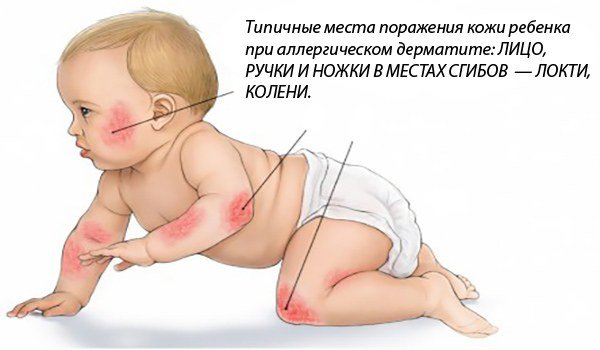
- The pediatric stage is observed at the beginning of the second year of life of children and is capable of accompanying a small patient until adolescence. Dr. Komarovsky states that between the ages of 6 and 12 years, dry hand and foot syndrome may appear. This is manifested by cracking of the skin as a result of insufficient hydration. The rash can spread to all parts of the body, but favorite places are the chest, neck, elbows and the area behind the knees.
- Adolescent stage - appears during the patient’s puberty. The rash can be localized on any part of the body. If such symptoms develop, consultation with specialists is required, especially with a dermatologist, who will diagnose and prescribe therapeutic measures, including the use of external agents (ointments, creams, gels, etc.).
It is important to consider that children with weakened immune systems are most often susceptible to allergic dermatitis, so in no case should you self-medicate. This can increase negative symptoms and lead to undesirable consequences.
Classification of childhood atopic dermatitis
Depending on the age at which symptoms appeared:
- Infant form (up to 3 years);
- Children's uniform (3-12 years old);
- Teenage form (12-18 years old).
By prevalence:
- Limited dermatitis (up to 5% of body surface);
- Widespread dermatitis (5-15% of the body surface, lesions are observed in several areas);
- Diffuse (such forms can be characterized by extensive and deep skin lesions).
According to the allergen that caused the disease:
- Food;
- Pollen;
- Tick;
- Fungal and others.
Diagnosis of atopic dermatitis in children
At the initial stage, it is urgently necessary to consult a doctor, because the further state of the child’s health depends on timely diagnosis.
Diagnosis of the disease should be carried out by qualified pediatric dermatologists and immunologists-allergists. At the appointment, they examine the child and collect an allergy history and determine the possible causes of the disease. During examination, the skin color, elasticity, presence of rashes, as well as their nature, size, and location are assessed.
Next, studies should be carried out that will help the doctor make a differential diagnosis and distinguish atopic dermatitis from psoriasis, scabies and pityriasis rosea (the clinical picture of these diseases is similar). A general blood test is prescribed - usually an increased number of eosinophils is detected, which indicates the allergic nature of the disease. The amount of antibodies in the blood (immunoglobulin E-mediated allergic reactions) is also determined by ELISA or skin prick test.
If the diagnosis is confirmed, then a scratch test is prescribed. The suspected allergen is applied to the child's forearm and small scratches are made with a scarifier. If after 15-20 minutes redness, itching and swelling are observed, this indicates an allergy to this irritant.

Treatment of atopic dermatitis in children: basic principles
Since this disease is chronic, the doctor’s main task is to prevent relapses, as well as the so-called “atopic march.” The essence of this concept is that with incorrect or untimely treatment, the disease may seem to recede. But by the age of 6-7 years, the child shows signs of allergic rhinitis or bronchial asthma, and in some cases, two diseases at once. And these diseases, in turn, can be complicated by adenoids, otitis, diseases of the larynx and even suffocation. To avoid complications in the future, you need to start treatment immediately.
Diaper dermatitis
Manifests itself when the child is not cared for properly:
- not frequent bathing;
- changing a diaper at the wrong time.
Another reason may be mechanical damage. After all, babies still have an imperfect thermoregulation system and very delicate skin.
Symptoms of this type of dermatitis are inflammation of areas of the dermis that touch the wet diaper. Children are restless, because the skin in the affected areas is very itchy. More often observed in girls from six months to a year, it can lead to vulvitis.
Treatment methods for infants
In order to put the disease into remission, the following methods are used:
- Avoid contact with the allergen. Most often, at this age, the allergen is a food product. If a rash appears after consuming a new formula or introducing complementary foods, you should immediately stop it.
- Lubricate the affected areas of the skin with moisturizing creams or ointments. Bepanten is ideal - it does not irritate the skin, is hypoallergenic, and can be used from the first days of a child’s life.
- Make sure that the child does not sweat or overheat.
Usually, if the course of the disease is not complicated, then these measures are enough to ensure that all unpleasant symptoms go away.
Treatment of children over one year old
If we are talking about a one-year-old child or an older child, it is also necessary to reconsider his diet - often the cause of the rash lies precisely in it; information about nutrition for atopy is in this article. Avoid sweets, citrus fruits, red and orange fruits and vegetables for a while. Drug treatment includes the following measures:
- Application of ointments and creams. If there are wet areas, then a drying agent (zinc ointment) is prescribed, which should be smeared 2-3 times a day. If, on the contrary, there is dryness and flaking of the skin, then the best remedy will be the following drugs: bepanten, pimafucort (allowed for use from 1 year), hydrocortisone ointment, local antihistamines. They will help relieve itching and swelling, easing the child's condition.
- Antihistamines, immunomodulators, vitamins A, C, E, B, minerals, and topical steroids are also prescribed internally.
- If a secondary infection occurs, hospitalization in a hospital is desirable and the use of antibiotics is necessary. However, you need to remember that you need to drink them only under the supervision of a doctor and, at the same time as antimicrobial drugs, use probiotics, for example, normoflorin. This is very important because... there is a risk of developing dysbiosis.
Note! Under no circumstances should you self-medicate, especially use untested and folk remedies. All drugs must be officially registered, comply with GOST and be taken under the supervision of a specialist. Remember that only a doctor can determine the duration and dosage of medication use.
During treatment, you need to constantly monitor the child’s condition and follow recommendations that will alleviate the general condition. These include the following:
- Hypoallergenic mode. It includes not only the exclusion of food allergens, but also vigilance towards household ones. You need to ventilate the apartment more often, do wet cleaning, and limit contact with your pet, if you have one. Do not use new hygiene products. Provide the child with the most comfortable environment possible.
- Diet and diet. Monitor the quantity and quality of food your child eats. Do not allow your child to uncontrollably consume sweets or fruits.
- Physiotherapy. Nowadays, reflexology, thalassotherapy, hyperbaric oxygenation, phototherapy (irradiation with UV lamps), climatotherapy, and spa treatment are widely used.
Often children with atopic dermatitis, especially schoolchildren, need the help of a psychologist. Sometimes there are cases when the cause is psychosomatic. This recommendation should not be neglected, because communication with a specialist can help the child adapt to the team.
How does allergic dermatitis manifest in children?
Common manifestations of allergic dermatitis are:
- Hyperemia and swelling of the skin, less often the mucous membrane;
- The appearance of an urticarial or maculopapular rash;
- Itching, restlessness of the baby, refusal to eat;
- Dryness and flaking of the skin, small cracks may appear;
- Scratching and secondary infection.
It should be noted that allergic dermatitis, in its clinical symptoms, does not have pathognomonic (characteristic only for this disease) signs, so a non-specialist can easily confuse it with other, more serious pathologies. Therefore, if a rash appears in a child, it is necessary to immediately seek medical help.
Doctor Komarovsky's opinion
The famous pediatrician Komarovsky has his own point of view on the causes and treatment of atopic dermatitis in children.
He believes that the problem lies not only in the quality, but also in the quantity of food. It often happens that the cause of atopic dermatitis is sought in a specific product, but this is not entirely true. Komarovsky says that when harmful substances cannot be completely neutralized, they enter the blood from the intestines. And then the body tries to remove them along with sweat, the skin reacts to this and a rash appears.
But even sweat itself does not always cause manifestations of dermatitis. Sometimes the secretion of the sweat glands interacts with substances that enter the skin from the outside. And it is these reactions that are key in the development of atopic dermatitis.
How is it possible to reduce the load on the intestines and reduce the amount of harmful substances absorbed into the blood? You just need to reduce the amount of food you consume. Practicing pediatricians confidently state that atopic dermatitis is very rare in thin children. And if a child who suffers from atopic dermatitis gets an intestinal infection and hardly eats for several days, then the rash becomes much smaller. This once again confirms the fact that the main problem is overeating.
This is confirmed by the fact that atopic dermatitis very often appears in children who are bottle-fed. The problem is that when the stomach is full, the feeling of fullness comes to the child only after 10-15 minutes. If the baby is breastfed, then he eats the required amount of food in 7-10 minutes, and then simply sucks the breast, calms down, and so on until a feeling of satiety comes.
If the baby eats from a bottle, he will continue to suck on the formula until he is satisfied. Generally speaking, all children who eat formula from a bottle overeat to one degree or another, which cannot but affect the condition of their intestines. After all, there are not many enzymes anyway, and if 1.5 times more food enters the body than necessary, then it will linger in the intestines, rot, and then the breakdown products will be absorbed into the blood.
Unfortunately, most parents are more likely to panic when a child is malnourished. But no one notices the dangers of overeating, which leads to such a huge number of children suffering from atopic dermatitis. And every year this number only increases.
Dr. Komarovsky urges parents to monitor not only what the child eats, but also the quantity in which he eats it. It is better to adhere to the principle of fractional nutrition (give food in small quantities, but often). It is also necessary to monitor how bowel movements occur, because any constipation is a prerequisite for the occurrence of atopic dermatitis. The same goes for mothers who breastfeed. If you have digestive problems, you can take Picolax, Enterosgel - these drugs will speed up the removal of harmful substances from the intestines.
It is also important to monitor the temperature, says the doctor. Do not overheat the child so that the “greenhouse effect” does not occur. It is enough to control the temperature and humidity in the room, as well as monitor the child’s physical activity. If he is sweating, he needs to change his clothes. It is also necessary to remember that clothes and bedding that are in direct contact with the child’s skin must be made of 100% natural material - this will allow the body to breathe.
Symptoms
The photos of allergic dermatitis in children, which can be found on the Internet, show completely different signs of this disease. That is why a person who does not have a medical education often cannot make a correct diagnosis.
The main classic signs and symptoms that a baby has developed allergic dermatitis are as follows:
- skin rashes;
- peeling and hyperemia (redness) of the skin;
- the occurrence of itching and discomfort;
- thickening of the skin with increased pattern on it.
The inflamed areas of the skin may not be very noticeable initially, but after some time the symptoms of the disease appear significantly. For the child form, the following symptoms may be characteristic:
- the appearance of a rash on the elbows and knees, as well as in the neck;
- swelling of the skin and its redness;
- the appearance of crusts, erosions and plaques.
When babies develop blisters, clear fluid accumulates in them. Over time, due to mechanical damage, these formations are destroyed, resulting in wounds appearing in their place. They soon become covered with crusts and plaques, which babies often scratch.
Skin manifestations of allergies in children are often accompanied by infection. This is due to the fact that wounds on the skin become an open source of entry of pathogenic organisms into the body.
The age of the child does not significantly affect the area of affected skin. At the same time, newborn babies react very unfavorably to large areas of allergies. This problem can be deadly for them, since it results in severe intoxication.
On the face, allergic dermatitis, as can be seen from the photos of children, occurs quite often. This is due to the fact that in early childhood a child takes many different objects into his mouth. Not all of them are safe for him.
Thus, depending on the symptoms of allergic dermatitis, treatment can be completely different. Therefore, before using any means, you should contact a medical facility.
Prognosis of the course of atopic dermatitis
If treatment protocols are followed and regular monitoring by a specialist, the prognosis of the disease is very favorable. Most children easily experience dermatitis by the age of 6-7 years and unpleasant symptoms never appear again. However, if left untreated or not treated correctly, there is a high likelihood that atopic dermatitis will cause severe illness in the future. And despite the fact that atopic dermatitis is a chronic disease and it is almost impossible to cure it completely, modern medicine offers many methods that will help avoid exacerbation and bring the disease into remission.
Complications of atopic dermatitis
Among the complications are diseases of an allergic nature, which include the following: allergic rhinitis, bronchial asthma. There are also a number of complications of a non-allergic nature: otitis media, adenoids, pharyngitis, false croup, disorders of the gastrointestinal tract and central nervous system. They will not occur immediately, but untreated atopic dermatitis will lead to a series of diseases in which one will become a complication of the other.
In addition to all of the above, doctors have identified a pattern: children suffering from atopic dermatitis are 1.5 times more likely to suffer from respiratory diseases and are more susceptible to viral infections. Allergies are a strong blow to the body’s immune system, so ignoring the problem is simply unacceptable!
Why is infantile allergic dermatitis called atopic?
If you look at the translation of the word “atopy” from Greek, it becomes clear that this is the same thing as “strange” or “unusual”. What is unusual in this situation is that the body’s protective function is not triggered by the immune system itself. The baby’s body reacts to the allergen by excessively producing antibodies, which, instead of protecting, provoke failure and disruption in its functioning. Until the immune system is strengthened and adjusted to work properly, the child will be at risk of allergic dermatitis. There are several criteria for the occurrence of atopy:
- hereditary tendency transmitted with the genes of the parents;
- factors that irritate from the outside - all kinds of food, household and personal hygiene items, industrial chemical allergens.
It is incorrect to say that a specific disease is directly transmitted from mother to child, since what is inherited is only the ability to realize it under the necessary circumstances. The main role in this is played by neurogenic motivators, such as stressful situations and increased excitability. Characteristic symptoms in the form of rashes are observed in babies in the first six months of life, but exacerbations can also occur in adolescence. Even in cases where both parents have never experienced this type of disease, children still suffer from allergies in 10–20% of cases.
When one of the parents has a tendency to allergies, then the chances that a child will be born with an acquired reaction are ½, but when both mom and dad suffered from this disease, then the probability of inheritance increases to 80%.
It is possible that allergic dermatitis will overtake an adult. Allergic dermatitis in a child is characterized by a long period of progression with cyclical rashes on the skin, which usually begin with a feeling of itching. The first manifestations are usually associated with food intake. Frequent allergenic foods include chicken eggs, various berries and fruits, oranges, tangerines, cow's milk, cereals, and soy foods. Based on this, doctors strongly recommend introducing complementary foods starting with a minimum volume and you need to carefully monitor possible reactions of the baby’s body.

Peaches in the diet of a nursing mother can cause allergies in the baby
Breast milk also serves as a carrier of allergic components: when the mother allows herself strawberries or peaches, the baby may develop a rash in response to this. Irritation caused by medications, vaccinations, insect bites, and pollen is also not uncommon. Children's allergic dermatitis is often called diathesis. This refers to a tendency to certain diseases or unusual reflexes to common pathogens.
Preventive measures
Regardless of whether the child has ever had atopic dermatitis, or whether he simply has a hereditary predisposition to this disease, certain recommendations must be followed. They will help avoid the disease or keep it in remission.
- Maintaining a healthy lifestyle by the mother during pregnancy (regular physical activity, medical examination, proper nutrition, taking vitamins, giving up bad habits);
- It is necessary to give preference to breastfeeding, if possible (this way, immunoglobulins enter the child’s body, the immune system is strengthened, and the risk of hypersensitivity of all types is reduced);
- Compliance with the diet by the mother during breastfeeding, exclusion of possible allergens;
- Maximum protection of the child from products and other factors that can trigger the onset of the disease;
- Proper rest and sleep mode. Avoiding stress and overload of the body;
- Temperature conditions in the room where the child is (optimal temperature – 20 degrees, humidity – 50-70%);
- Treatment of concomitant chronic diseases, if any;
- Spa treatment, drinking mineral waters;
- Proper child skin care. If we are talking about a child before reaching the age of one month, it is necessary to avoid diaper rash, change diapers more often, and bathe the child daily. For baths you can use decoctions of chamomile, oak bark, string, plantain, and calamus root. If you need to dry the skin, you can add a little potassium permanganate to the bath (until a pale pink color is obtained). Oilcloths, woolen and synthetic underwear are contraindicated for such children.
Older children should also take care of personal hygiene: take cool baths, warm showers, lubricate the skin with moisturizers, and give preference to natural fabrics in clothing. To avoid acute respiratory viral infections, children with diathesis and atopic dermatitis need to be hardened and take more frequent walks in the fresh air. But if there is an epidemic in the city, it is better to avoid places with large crowds of people. Use only hypoallergenic powders, soaps, powders and other cosmetics. When using a hygiene product for the first time, perform an allergy test (apply a small amount to the forearm and observe the skin reaction). All these recommendations will make it possible to protect your child from the manifestations of atopic dermatitis, and in combination with proper treatment, they will save him from this disease forever.
How to treat an allergic skin reaction with home remedies?
It should be noted right away that treatment with home remedies can only be considered as an addition to the main therapy prescribed by a pediatrician or allergist. In folk medicine, there are many recipes that help cope with skin manifestations of allergic dermatitis.
An ointment is often used for allergic dermatitis in children, which is prepared from propolis. It has excellent antiseptic and wound healing properties, and also significantly reduces itching. But before applying it, it is necessary to exclude the baby’s intolerance to its components. To do this, apply a minimal amount of ointment to the back of the forearm and evaluate the result after an hour. If redness or a papule appears in this area, then the ointment cannot be used.
For example, lotions made from aloe and grated raw potatoes, as well as apples, are often used. They help reduce inflammation, have an antiseptic effect and saturate the skin with essential vitamins and microelements. You can also use rubs or the same lotions with decoctions of green tea, calendula, chamomile, and oak bark.
How to prevent repeated relapses of allergic dermatitis?
In order to avoid the recurrence of allergic rashes, you must:
- Completely exclude the child from contact with the identified allergen.
- Follow a hypoallergenic diet
- Use only hypoallergenic shampoo, soap, baby cream and washing powder
- Thoroughly carry out wet cleaning and ventilation of the room where the child is located.
- Avoid contact with pets as a possible source of allergies
- Be very careful when introducing new foods into your baby's diet.
- Prevent dysbacteriosis by regularly giving the child medications containing bifidobacteria and lactobacilli
- Maintain a sleep-wake schedule
- Try to spend time with your child in the fresh air as often as possible (with the exception of the flowering period of plants that cause allergies)
Of course, raising a healthy and strong baby is a difficult task that requires maximum dedication and great attention from parents. Therefore, try to follow all the above rules and recommendations of the pediatrician, and then your baby will delight you with excellent health.
